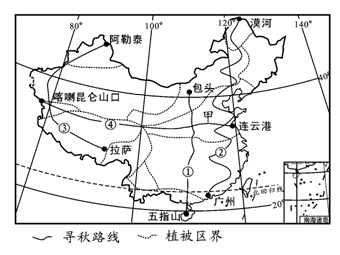“从北到南,从西到东,不知从哪天起,秋的画卷如火如荼次第展开,转眼间就醉了大半个中国”,《中国国家地理》杂志社策划了“三纵一横”四条路线寻访秋天的活动。线路分布如图所示,读图完成题。

小题1:当寻秋的摄影师途经甲植被区时,看到的景观最有可能是

小题2:我国四季类型组合丰富,寻秋路线中只经历了“冬冷夏热,四季分明”和“长夏无冬,秋去春来”两种类型的是
A.路线①
B.路线②
C.路线③
D.路线④
小题1:C
小题2:A
题目分析:
小题1:由图可知,甲区域位于华北地区,为温带季风气候,植被应是温带落叶阔叶林,与C图景观一致。
小题2:“冬冷夏热,四季分明”应位于的温带地区,“长夏无冬,秋去春来”应位于我国的热带地区,图示只有线路①经过了这两种地区。
点评:本题难度一般,掌握我国的区域气候类型、气候特征和植被类型的分布是解题的关键,注意结合地图综合比较分析。
